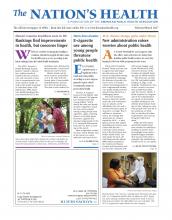For the first time in decades, U.S. life expectancy dropped in 2015, with preventable chronic diseases remaining a leading cause of death.
In December, the Centers for Disease Control and Prevention’s National Center for Health Statistics released “Mortality in the United States, 2015,” finding that in 2015, U.S. life expectancy at birth was 78.8 years — a decrease of 0.1 year from 78.9 years in 2014. Among American men, life expectancy dropped from 76.5 years to 76.3 years, while women’s life expectancy declined from 81.3 years in 2014 to 81.2 years in 2015.
The 10 leading causes of deaths were the same in 2015 as they were in 2014: heart disease, cancer, chronic lower respiratory diseases, unintentional injuries, stroke, Alzheimer’s disease, diabetes, influenza and pneumonia, kidney disease and suicide.
The report also found that the age-adjusted death rate for the U.S. population increased 1.2 percent from 724.6 deaths per 100,000 population in 2014 to 733.1 per 100,000 in 2015, with such rates increasing among black males, white males and white females. On the nation’s infant mortality rate, which the report noted is a “good indicator of the overall health of a population,” researchers found that while the rate increased, the change was not statistically significant.

The U.S. infant mortality rate has remained statistically steady, but lags behind many similar high-income countries.
Photo by JBrownInTheLight, courtesy iStockphoto
According to the report, the U.S. infant mortality rate increased from 582.1 infant deaths per 100,000 live births in 2014 to 589.5 deaths per 100,000 births in 2015. The leading causes of infant death — congenital malformations, low-birthweight, sudden infant death syndrome, maternal complications and unintentional injuries — remained the same from 2014 to 2015.
Also on the topic of life expectancy, the 2016 “America’s Health Rankings Annual Report,” which was released in December, compared the U.S. to other countries in the Organization for Economic Co-operation and Development, finding that the U.S. ranks 26th in life expectancy out of 35 nations.
Japan topped the life expectancy list at 84 years, with nearly all western European countries, as well as Canada and Australia, topping the U.S. Twenty-five countries had a life expectancy of at least 80 years, compared to the U.S. average of 79 years.
The rankings report also found that the U.S. ranks 29th in infant mortality when compared against the other 35 nations. The infant mortality rate in 14 other countries, such as Japan and Slovenia, was half the U.S. rate. The report’s authors noted that infant mortality and life expectancy rankings “continue to be disappointingly low in the United States, especially considering how much money is spent on health.” Among the nations, the U.S. is home to the highest health spending.
Global comparisons were also the focus of an 11-country survey from the Commonwealth Fund. Published in Health Affairs in November, the survey found that Americans are often sicker and experience more emotional distress than their counterparts in other high-income nations. In interviewing nearly 27,000 adults in Australia, Canada, France, Germany, the Netherlands, New Zealand, Norway, Sweden, Switzerland, the United Kingdom and the U.S., researchers reported that the U.S. was home to the highest rate of respondents living with multiple chronic diseases, at 28 percent.
In addition, about 33 percent of U.S. adults went without recommended care or could not fill a prescription due to cost. In comparison, about 7 percent of respondents in the United Kingdom and Germany and 8 percent in the Netherlands and Sweden reported cost-related health barriers.
On a more positive note, however, just 6 percent of U.S. adults reported waiting longer than two months for an appointment with a specialist. Also, the U.S. was the only country where a majority of adults said they had discussed healthy diets and exercise with their physicians in the previous two years.
“Previous surveys have shown that, especially compared to other industrialized nations, the U.S. has far too many people who can’t afford the care they need, even when they have health insurance,” said study lead author Robin Osborn, MBA, vice president and director of the Commonwealth Fund’s International Program in Health Policy and Practice Innovations, in a news release.
For more information on the 11-country survey, visit www.commonwealthfund.org. To download “Mortality in the United States, 2015,” visit www.cdc.gov/nchs. To access America’s Health Rankings, visit www.americashealthrankings.org.
- Copyright The Nation’s Health, American Public Health Association









